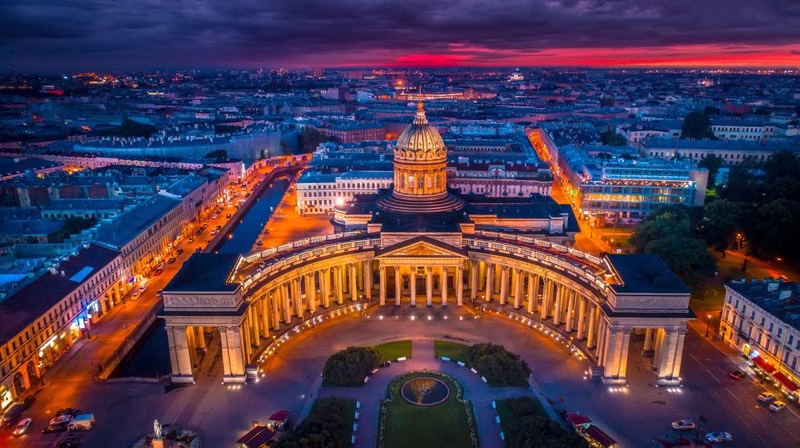Kazansky Cathedral
At the beginning of the 18th century, a small wooden church of the Kazan Mother of God appeared on Nevsky Prospekt. In subsequent years, a stone church called Rozhdestvensky was built in its place. The Kazan Icon of the Mother of God was delivered to the temple, in honor of which it was named Kazan Icon.
During the reign of Emperor Paul I, the old building needed reconstruction, and therefore it was decided to erect a temple in the capital of the Russian Empire, which had no less merits than the Roman Cathedral of St. Petra. After considering many proposals, the choice fell on the project of Andrei Nikiforovich Voronikhin, the former serf count Stroganov. The construction of the cathedral was completed in 1811, and Voronikhin was awarded the Order of Anna. The construction of the church was carried out by Russian serfs, and construction materials were brought from different parts of Russia. An absolutely stunning creation of the architect is the colonnade, consisting of 96 13-meter columns arranged in a semicircle, emphasizing the central part of the cathedral.
Four sculptures appeared on the territory adjacent to the Kazan Cathedral: Prince Vladimir, John the Baptist, Andrei Pervozvanny and Alexander Nevsky. The doors of the temple are copied from the doors of the Florentine baptismal house. The interior of the cathedral is similar to the luxurious palace rooms, and the sun rays falling from the window skylights visually increase the height of the dome. The icons in the cathedral were created with a brush of great Russian artists.
The Kazan Cathedral is inseparable from all significant historical events. It was here that a prayer service was held, after which Mikhail Kutuzov went to the battlefield, and after his death, the great Russian commander was buried in the Kazan Cathedral in the crypt, next to which military trophies. Also in the cathedral there are memorable sculptures of Kutuzov and Barclay de Tolly.
In Soviet times, services in the Kazan Cathedral ceased, and a museum of the history of religion was opened in the building itself. The famous icon of Our Lady of Kazan was transferred to the Prince Vladimir Cathedral. The Kazan Cathedral was also damaged during the Great Patriotic War - during the blockade, part of the building was destroyed by shells. In the postwar years, the building underwent reconstruction and major repairs.
After the collapse of the Soviet Union, divine services resumed in the largest cathedral in St. Petersburg, and the cross removed after the revolution was reinstalled on the dome, and the icon of the Mother of God was returned to its original place.
Address
Kazanskaya pl., 2
Address
Kazanskaya pl., 2
Address
Kazanskaya pl., 2
Timetable
Mon—Sat 9:00-19:45, Sun 6:30 — 19:45
Timetable
Mon—Sat 9:00-19:45, Sun 6:30 — 19:45
Timetable
Mon—Sat 9:00-19:45, Sun 6:30 — 19:45
Phone
+7 981 930-08-01
Phone
+7 981 930-08-01
Phone
+7 981 930-08-01
Website
Kazansky Cathedral
Website
Kazansky Cathedral
Website
Kazansky Cathedral
Source
https://kudago.com/spb/place/kazanskij-sobor/
Source
https://kudago.com/spb/place/kazanskij-sobor/
Source
https://kudago.com/spb/place/kazanskij-sobor/


